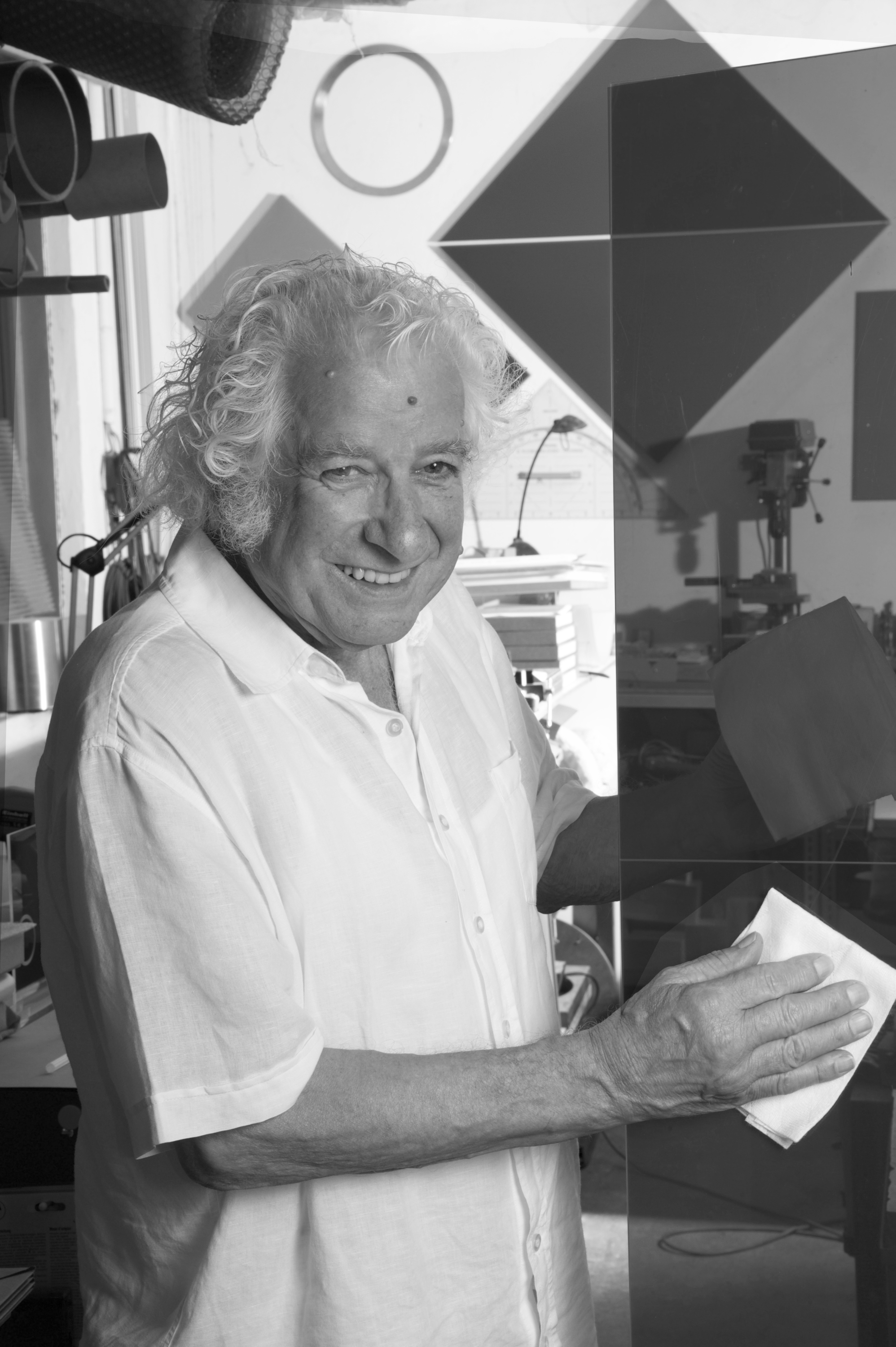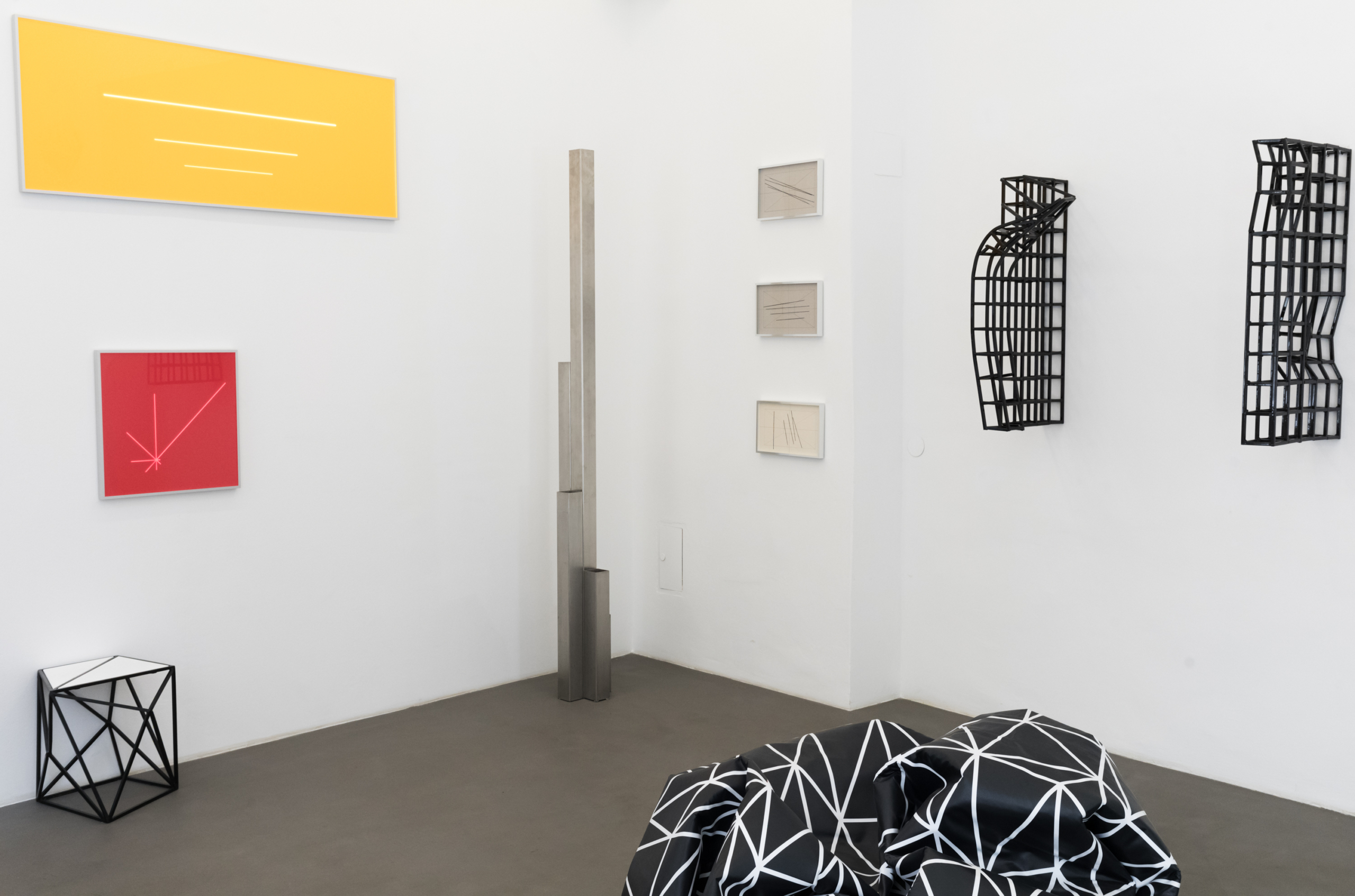Hellmut Bruch
„Immaterialität im Zusammenwirken mit der Materialität”
Die zentralen Themen sind das Licht und Proportionen, die sich auf Naturgesetzlichkeiten beziehen und in »offenen Formen« Gestalt annehmen. Edelstahl und transparentes, farbiges, fluoreszierendes Acrylglas sind meine bevorzugten Materialien. Die Arbeiten beziehen sich auf das Licht als »offenes Medium«,auf die Gravitation und auf die Fibonacci-Folge bzw. auf den »Goldenen Schnitt«. “Weil ich mich auf die Realität des Immateriellen beziehe, sind meine Plastiken und Skulpturen keine reduzierten Abbildungen oder Abstraktionen des Sichtbaren, sondern folgen jenen Voraussetzungen, die der materiellen Welt Gestalt geben und sie prägen. Die so entstandenen »Offenen Formen« bauen auf universale Konstanten und münden in die Unendlichkeit.”
„Immateriality in interaction with materiality”
The central themes are light and proportions, which refer to natural laws and take shape in “open forms”. Stainless steel and transparent, colored, fluorescent acrylic glass are my preferred materials. The works refer to light as an “open medium”, to gravity and to the Fibonacci sequence or the “golden ratio”. “Because I refer to the reality of the immaterial, my sculptures are not reduced representations or abstractions of the visible, but follow the conditions that give form to the material world and shape it. The resulting “open forms” are based on universal constants and lead to infinity.”

Hellmut Bruch, geboren 1936 in Hall in Tirol, ist ein österreichischer Künstler, der sich intensiv mit den Themen Licht und Proportion auseinandersetzt. Seine Arbeiten basieren auf universellen Naturgesetzen und manifestieren sich in “offenen Formen”. Bevorzugte Materialien sind Edelstahl sowie transparentes, farbiges und fluoreszierendes Acrylglas, die das Licht einfangen und reflektieren.
Bruch absolvierte seine künstlerische Ausbildung in Österreich, bevor er sich intensiv mit konstruktiven und minimalistischen Kunstströmungen beschäftigte. Inspiriert von der geometrischen Abstraktion, entwickelte er eine unverwechselbare Formsprache, die sich durch Klarheit, Reduktion und die gezielte Einbeziehung von Licht auszeichnet. Er wurde für seine Arbeit mehrfach ausgezeichnet, darunter mit dem Ehrenzeichen der Stadt Hall und dem Verdienstkreuz des Landes Tirol.
Bruchs Arbeiten sind international anerkannt und wurden in zahlreichen Ländern ausgestellt, darunter Belgien, Brasilien, Kanada, Deutschland, England, Frankreich, Italien, Japan, Korea, Polen, Russland, Schweden, Schweiz, Slowenien, Spanien, Südafrika, Ungarn und den USA. Seine Werke sind in öffentlichen und privaten Sammlungen vertreten und bereichern den öffentlichen Raum mit ihrer Präsenz.
Hellmut Bruch, born in Hall in Tyrol in 1936, is an Austrian artist who deals intensively with the themes of light and proportion. His works are based on universal laws of nature and manifest themselves in “open forms”. His preferred materials are stainless steel and transparent, colored and fluorescent acrylic glass, which capture and reflect the light.
Bruch completed his artistic training in Austria before becoming intensively involved with constructivist and minimalist art movements. Inspired by geometric abstraction, he developed an unmistakable formal language characterized by clarity, reduction and the targeted inclusion of light. He has received several awards for his work, including the Decoration of Honor of the City of Hall and the Cross of Merit of the Province of Tyrol.
Bruch’s work is internationally recognized and has been exhibited in numerous countries, including Belgium, Brazil, Canada, Germany, England, France, Italy, Japan, Korea, Poland, Russia, Sweden, Switzerland, Slovenia, Spain, South Africa, Hungary and the USA. His works are represented in public and private collections and enrich the public space with their presence.
Ein zentrales Element in Bruchs Werken ist die Anwendung der Fibonacci-Folge und des Goldenen Schnitts, die als grundlegende Prinzipien der Harmonie und Ästhetik in der Natur gelten. Durch die Integration dieser Proportionsgesetze in seine Skulpturen und Installationen schafft er Werke, die sowohl visuell ansprechend als auch mathematisch fundiert sind. Ebenfalls ein zentrales Motiv seiner Arbeiten ist das Konzept der “offenen Formen”, bei denen Licht als immaterielles Medium genutzt wird, um das Wesentliche durch einfachste Mittel auszudrücken.
Seit den 1970er-Jahren experimentierte er mit transparenten und reflektierenden Materialien wie Edelstahl und fluoreszierendem Acrylglas, um die Wechselwirkungen von Form und Licht in den Raum zu übertragen. Seine Arbeiten basieren auf der Idee „offener Formen“, die den Betrachter in den Schaffensprozess mit einbeziehen und eine meditative Reflexion über Proportionen und Wahrnehmung ermöglichen. Dieses fast vergessene, universale und klassische Harmoniegesetz, das sich der Mensch von der Natur abgeschaut hat, gewinnt immer mehr an Aktualität und Bedeutung. Es wird als Wachstums- und Formbildungsgesetz in den verschiedenen wissenschaftlichen Disziplinen erkannt.
Diese Erkenntnisse begeistern und inspirieren Hellmut Bruch. “Ich begegne ihnen auf elementare Weise und wünsche mir, dass dies durch meine Werke spür- und erfahrbar wird. Der Inhalt zielt auf Proportionen und auf das Licht, das einfach gesagt, selbst nicht sichtbar ist, aber uns die Welt sichtbar macht. Was mich an beiden Phänomenen interessiert, ist ihre »Immaterialität« im Zusammenwirken mit der »Materialität« des Wahrnehmbaren.” Seine Skulpturen, oft aus transparentem oder farbigem Acrylglas gefertigt, interagieren intensiv mit dem Licht und erzeugen leuchtende, klare geometrische Formen, die den Betrachter in eine Auseinandersetzung mit Raum und Unendlichkeit ziehen.
A central element in Bruch’s works is the application of the Fibonacci sequence and the golden ratio, which are considered fundamental principles of harmony and aesthetics in nature. By integrating these laws of proportion into his sculptures and installations, he creates works that are both visually appealing and mathematically sound. Another central motif in his work is the concept of “open forms”, in which light is used as an immaterial medium to express the essential through the simplest of means.
Since the 1970s, he has experimented with transparent and reflective materials such as stainless steel and fluorescent acrylic glass in order to transfer the interaction of form and light into space. His works are based on the idea of “open forms”, which involve the viewer in the creative process and enable meditative reflection on proportions and perception. This almost forgotten, universal and classical law of harmony, which man has copied from nature, is becoming increasingly topical and significant. It is being recognized as a law of growth and form in the various scientific disciplines.
These insights excite and inspire Hellmut Bruch. “I encounter them in an elementary way and hope that this can be felt and experienced through my works. The content focuses on proportions and on light, which, to put it simply, is not visible itself, but makes the world visible to us. What interests me about both phenomena is their “immateriality” in interaction with the “materiality” of the perceptible.” His sculptures, often made of transparent or colored acrylic glass, interact intensively with the light and create luminous, clear geometric forms that draw the viewer into a confrontation with space and infinity.
Hellmut Bruch – Kunst als sichtbare Harmonie der Natur
Hellmut Bruch erschafft Kunst, die die universellen Prinzipien von Licht, Proportion und Raum in einer klaren, reduzierten Formensprache vereint. Geprägt vom Goldenen Schnitt und der Fibonacci-Folge, manifestieren sich seine Skulpturen und Installationen als präzise gesetzte Zeichen einer tiefen Ordnung – mathematisch fundiert, aber voller Leichtigkeit und Transparenz. Edelstahl und fluoreszierendes Acrylglas fangen das Licht ein, brechen es und lassen Strukturen entstehen, die je nach Perspektive und Umgebung in ständiger Veränderung begriffen sind. Bruchs Werke sind nicht nur Kunstwerke, sondern eine Einladung zur meditativen Wahrnehmung von Raum, Ordnung und Harmonie.
Künstlerisches Schaffen und zentrale Themen
Bruchs künstlerisches Werk vereint mathematische Ästhetik mit sinnlicher Wahrnehmung. Durch die Anwendung der Fibonacci-Folge und des Goldenen Schnitts entwickelt er Skulpturen, die in ihrer Struktur auf natürlichen Wachstumsprozessen basieren. Diese Prinzipien verwendet er nicht nur als formale Grundlage, sondern auch als inhaltliches Konzept, um die Ordnung der Natur sichtbar zu machen.
Seine bevorzugten Materialien – Edelstahl sowie transparentes, farbiges oder fluoreszierendes Acrylglas – verstärken den immateriellen Charakter seiner Arbeiten, indem sie Licht absorbieren, reflektieren oder durchlassen. So entstehen Skulpturen und Installationen, die mit der Umgebung interagieren und sich je nach Blickwinkel und Lichteinfall verändern.
Internationale Anerkennung und Ausstellungen
Bruchs großformatigen Installationen im öffentlichen Raum zeigen die eindrucksvolle Wirkung seiner reduzierten Formensprache. Ob in städtischer Umgebung oder in der Natur – seine Werke schaffen Orte der Ruhe, Reflexion und Wahrnehmungsschärfung. Seine Werke wurden international in zahlreichen Museen, Galerien und öffentlichen Räumen präsentiert. Viele seiner Arbeiten sind in bedeutenden Sammlungen vertreten und wurden in Ländern wie Deutschland, Frankreich, Italien, England, den USA, Japan und Südafrika ausgestellt.
Die freistehenden Edelstahlskulpturen und Installationen aus fluoreszierendem Acrylglas reflektieren das Sonnenlicht oder leuchten in intensiven Farben, wodurch sie sich je nach Tageszeit und Blickwinkel stetig verändern. Besonders in urbanen Räumen wirken Bruchs Werke als ruhige, klare Zeichen inmitten der Bewegung, während sie in natürlicher Umgebung die dort bereits vorhandene Ordnung aufgreifen und verstärken.
Bedeutung und Einfluss
Bruchs Kunst verbindet Wissenschaft, Philosophie und Ästhetik zu einer harmonischen Einheit. Seine Arbeiten fordern den Betrachter dazu auf, die Welt in ihrer mathematischen Ordnung zu erkennen und gleichzeitig die poetische Kraft von Licht und Proportion zu erleben. Durch seine konsequente Auseinandersetzung mit universellen Gesetzmäßigkeiten gehört Hellmut Bruch zu den bedeutenden Vertretern der konkreten Kunst und der geometrischen Abstraktion.
Mit seiner Reduktion auf essenzielle Formen und seiner Konzentration auf die Wechselwirkungen von Material, Licht und Raum schafft er Werke, die eine zeitlose Strahlkraft besitzen und über den Moment hinaus eine tiefere Reflexion über die grundlegenden Prinzipien der Natur ermöglichen.
Werke im öffentlichen Raum und Sammlungen
Hellmut Bruchs Arbeiten sind nicht nur in renommierten Museen und Galerien vertreten, sondern auch an zahlreichen öffentlichen Orten zu finden. Seine Skulpturen und Installationen wurden für den Außenraum konzipiert, wo sie in Verbindung mit der natürlichen Umgebung und dem wechselnden Licht eine dynamische Präsenz entfalten. Besonders beeindruckend sind seine großformatigen Arbeiten, die durch ihre klare Formensprache und mathematisch präzise Proportionierung architektonische Räume bereichern.
Zahlreiche Kunstsammlungen – sowohl private als auch öffentliche – beherbergen Werke von Hellmut Bruch. Dazu gehören bedeutende Institutionen wie die Artothek des Bundes in Österreich, das Museum für Konkrete Kunst in Ingolstadt sowie Sammlungen in Deutschland, Frankreich, Italien und Japan.
Einfluss und künstlerisches Erbe
Hellmut Bruchs Kunst ist tief in der Tradition der konkreten Kunst und der geometrischen Abstraktion verwurzelt, zugleich aber innovativ und zukunftsweisend. Sein Schaffen steht in der Tradition von Künstlern wie Max Bill, Georges Vantongerloo und den Vertretern der Zürcher Konkreten, die mathematische Gesetzmäßigkeiten als Grundlage für ästhetische Ordnungen betrachteten.
Seine Werke gehen jedoch über rein formale Strenge hinaus: Sie laden zur Reflexion über die universellen Prinzipien der Natur ein und verbinden Wissenschaft, Kunst und Philosophie in einer einzigartigen Weise. Die Auseinandersetzung mit Licht als immaterieller, aber zentraler künstlerischer Komponente macht sein Werk besonders relevant für zeitgenössische Diskurse über Wahrnehmung und Raumgestaltung.
Fazit
Hellmut Bruch hat sich über Jahrzehnte hinweg als herausragender Vertreter einer Kunst etabliert, die die Schönheit mathematischer Proportionen sichtbar macht und zugleich sinnliche Erlebnisse schafft. Seine reduzierten, aber wirkungsvollen Werke zeigen, dass Kunst und Naturgesetze untrennbar miteinander verbunden sind.
Mit seinen Skulpturen und Installationen hinterlässt Bruch ein Werk, das zeitlos ist und über den Moment hinaus Bestand hat. Er bleibt ein Künstler, dessen Arbeiten sowohl eine ästhetische Klarheit als auch eine tiefere philosophische Dimension besitzen – eine Einladung, die Ordnung und Harmonie der Welt mit neuen Augen zu betrachten.





